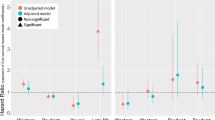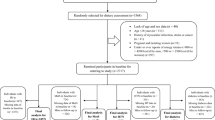Abstract
Objective:
To examine dietary factors predisposing to overweight and obesity, taking into account age, gender, education level and physical activity.
Design:
Longitudinal population study.
Setting:
Community living subjects in Hong Kong.
Subjects:
One thousand and ten Chinese subjects participating in a territory wide dietary and cardiovascular risk factor prevalence survey in 1995–1996 were followed up for 5–9 years.
Measurements:
Body mass index (BMI) was measured. Information was collected on factors predisposing to development of overweight and obesity (age, gender, education level, physical activity, macronutrient intake, Mediterranean diet score and food variety), and the predisposing dietary factors examined, adjusted for other confounding factors, using logistic regression.
Results:
The 5–9-year incidence of overweight is 22.6% (BMI ⩾23 kg/m2, 95% confidence interval (CI)=15.0–30.1%) or 11.5% (BMI ⩾25 kg/m2, 95% CI=7.3–15.7%), and for obesity (BMI ⩾30 kg/m2) is 0.6% (95% CI=−0.2–1.4%). The corresponding figures for women were 14.1% (95% CI=8.8–19.5%), 9.7% (95% CI=6.0–13.4%) and 3% (95% CI=1.3–4.8%). After adjusting for confounding factors (age, sex, education and physical activity), increased variety of snack consumption was associated with increased risk of developing overweight (BMI ⩾23 kg/m2) in the Hong Kong Chinese population over a 5–9-year period.
Conclusion:
Increased variety of snack consumption may predispose to weight gain over a 5–9-year period.
Sponsorship:
Research Grants Council and Health Services Research Fund, Hong Kong Government
This is a preview of subscription content, access via your institution
Access options
Subscribe to this journal
Receive 12 print issues and online access
$259.00 per year
only $21.58 per issue
Buy this article
- Purchase on Springer Link
- Instant access to full article PDF
Prices may be subject to local taxes which are calculated during checkout
Similar content being viewed by others
References
Bazzano LA, Song Y, Bubes V, Good CK, Manson JE, Liu S (2005). Dietary intake of whole and refined grain breakfast cereals and weight gain in men. Obes Res 13, 1952–1960.
Bell AC, Ge K, Popkin BM (2001). Weight gain and its predictors in Chinese adults. Int J Obes 25, 1079–1086.
Deurenberg-Yap M, Yian TB, Kai CS, Deurenberg P, van Staveren WA (1999). Manifestation of cardiovascular risk factors at low levels of body mass index and waist-to-hip ratio in Singapore Chinese. Asia Pacific J Clin Nutr 8, 177–183.
Drummond S, Crombie N, Kirk T (1996). A critique of the effects of snacking on body weight status. Eur J Clin Nutr 50, 779–783.
Francis LA, Lee Y, Birch LL (2003). Parental weight status and girls' television viewing, snacking, and body mass indexes. Obes Res 11, 143–151.
Fu FH, Hao X (2002). Physical development and lifestyle of Hong Kong secondary school children. Prev Med 35, 499–505.
Ghosh A, Bose K, Das C, Asit B (2003). Association of food patterns, central obesity measures and metabolic risk factors for coronary heart disease (CHD) in middle aged Bengalee Hindu men, Calcutta, India. Asia Pacific J Nutr 166–171.
Halkjaer J, Tjønneland A, Thomsen BL, Overvad K, Sørensen TIA (2006). Intake of macronutrients as predictors of five-year changes in waist circumference. J Nutr Health Ageing 10, 73.
Holland B, Welch AA, Unwin ID, Buss DH, Paul AA, Southgate DAI et al. (1992). The Composition of Foods. 4th edn. The Royal Society of Chemistry and Ministry of Agriculture, Fisheries and Food: UK.
Howard BV, Manson JE, Stefanick M, Beresford SA, Frank G, Jones B et al. (2006). Low fat dietary pattern and weight change over 7 tears. The Women's Health Initiative Dietary Modification Trial. JAMA 295, 39–49.
(2006): http://www.iotf.org/database/globaladultsaugust2005.asp, (accessed 21 February).
(2006): http://www.iotf.org/globalepidemic.asp, (accessed 21 February).
Hubert HB, Snider J, Winkleby MA (2005). Health status, health behaviours and acculturation factors associated with overweight and obesity in Latinos from a community and agricultural labor camp survey. Prev Med 40, 642–651.
Institute of Health (1992). Food Composition Tables. People's Health Press: Chinese Medical Sciences Institute, China. (Chinese).
Janus ED, For the Cardiovascular Risk Factor Prevalence Study Group (1997). Hong Kong Cardiovascular Risk Factor Prevalence Study 1995–1996. Department of Clinical Biochemistry: Queen Mary Hospital, Hong Kong.
Kelishadi R, Pour MH, Sarraf-Zadegan N, Sadry GH, Ansari R, Alikhassy H et al. (2003). Obesity and associated modifiable environmental factors in Iranian adolescents: Isfahan Heart Healthy Program—Heart Health Promotion from childhood. Paediatr Int 45, 435–442.
Kim S, Haines PS, Siega-Riz AM, Popkin BM (2003). The Diet Quality Index-International (DQI-I) provides an effective tool for cross-national comparison of diet quality as illustrated by China and the United States. J Nutr 133, 3476–3484.
Kirk TR (2000). Role of dietary carbohydrate and frequent eating in body-weight control. Proc Nutr Soc 59, 349–358.
Ko GTC, Chan JCN, Cockram CS, Woo J (1999). Prediction of hypertension, diabetes, dyslipidemia or albuminuria using simple anthropometric indexes in Hong Kong Chinese. Int J Obes 23, 1136–1142.
Leung R, Woo J, Chan D, Tang N (2000). Validation of prediction equations for basal metabolic rate in Chinese Subjects. Eur J Clin Nutr 54, 551–554.
McCrory MA, Fuss PJ, McCallum JE, Yao M, Vinken AG, Hays NP et al. (1999). Dietary variety within food groups: association with energy intake and body fatness in men and women. Am J Clin Nutr 69, 440–447.
Moreno LA, Sarria A, Popkin BM (2002). The nutrition transition in Spain: a European Mediterranean country. Eur J Clin Nutr 56, 992–1003.
Nicklas TA, Yang SJ, Baranowski T, Zakeri I, Berenson G (2003). Eating patterns and obesity in children. The Bogalusa Heart Study. Am J Prev Med 25, 9–16.
Notarbartolo A, Barbagallo CM (2001). Eating behaviour, body mass index and lipids of children in a free-living rural Sicilian population. Nutr Metab Cardiovasc Dis 11, 60–63.
Popkin BM (2001). The nutrition transition and obesity in the developing world. J Nutr 131, 871S–873S.
Schroder H, Marrugat J, Vila J, Covas MI, Elosua R (2004). Adherence to the traditional Mediterranean diet is inversely associated with body mass index and obesity in a Spanish population. J Nutr 134, 3355–3361.
Sea MMM, Woo J, Tong PCY, Chow CC, Chan JCN (2004). Associations between food variety and body fatness in Hong Kong Chinese adults. J Am Coll Nutr 23, 404–413.
Serra-Majem L, Ngo de la Cruz J, Ribas L, Tur JA (2003). Olive oil and the Mediterranean diet: beyond the rhetoric. Eur J Clin Nutr 57, S2–S7.
Sichieri R (2002). Dietary patterns and their associations with obesity in the Brazilian City of Rio de Janeiro. Obes Res 10, 42–48.
Simopoulos AP, Visioli F (2000). Mediterranean diets. World Review of Nutrition and Dietetics 87, Switzerland: Karger, Basel.
Sothern MS (2004). Obesity prevention in children physical activity and nutrition. Nutrition 20, 704–708.
Speed C (2004). The transposability of the Mediterranean-type diet in non-Mediterranean regions: application to the physician/allied health team. Eur J Cancer Prev 13, 529–534.
Trichopoulou A, Naska A, Orfanos P, Trichopoulos D (2005). Mediterranean diet in relation to body mass index and waist-to-hip ratio the Greek European Prospective Investigation into Cancer and Nutrition Study. Am J Clin Nutr 82, 935–940.
Trichopoulou A, Costacou T, Bamia C, Trichopoulos D (2003). Adherence to a Mediterranean diet and survival in a Greek population. N Engl J Med 348, 2599–2608.
Tur JA, Romaguera D, Pons A (2005). The Diet Quality Index-International (DQI-I): is it a useful tool to evaluate the quality of the Mediterranean diet. Br J Nutr 93, 369–376.
Vasan RS, Pencina MJ, Cobain M, Freiberg MS, D'Agostino RB (2005). Estimated risks for developing obesity in the Framingham Heart Study. Ann Intern Med 143, 473–480.
Wahlqvist ML, Kouris-blazos A, Wattanapenpaiboon N (1999). The significance of eating patterns: an elderly Greek case study. Appetite 32, 23–32.
Waller CE, Du S, Popkin BM (2003). Patterns of overweight, inactivity, and snacking in Chinese children. Obes Res 11, 957–961.
Warwick P (2006). Trends in energy and macronutrient intakes in non-under-reporters vary with the method used to identify under-reporters. J Hum Nutr Dietet 19, 31–40.
Woo J, Leung SSF, Ho SC, Chan SM (1999). Is there a typical Chinese diet and what are the health implications. Ecol Food Nutr 38, 491–503.
Woo J, Leung SSF, Ho SC, Lam TH, Janus ED (1997). A food frequency questionnaire for use in the Chinese population in Hong Kong description and examination of validity. Nutr Res 17, 1633–1641.
Woo J, Woo KS, Leung SSF, Chook P, Liu B, Ip R et al. (2001). The Mediterranean score of dietary habits in Chinese populations in four different geographical areas. Eur J Clin Nutr 55, 215–220.
World Health Organization (1998). Prevention and Management of the Global Epidemic of Obesity: Report of the WHO Consultation in Obesity. World Health Organization: Geneva, Switzerland. Report WHO/NUT/NCD/98.1.
Zimmet P (2001). Global and societal implications of the diabetes epidemic. Nature 414, 782–787.
Acknowledgements
The study was funded by the Research Grants Council of Hong Kong, project No. CUHK 7229/01M, and Health Services Research Grant No. 421001 1994–1995, Hong Kong Government.
Author information
Authors and Affiliations
Corresponding author
Rights and permissions
About this article
Cite this article
Woo, J., Cheung, B., Ho, S. et al. Influence of dietary pattern on the development of overweight in a Chinese population. Eur J Clin Nutr 62, 480–487 (2008). https://doi.org/10.1038/sj.ejcn.1602702
Received:
Revised:
Accepted:
Published:
Issue Date:
DOI: https://doi.org/10.1038/sj.ejcn.1602702
Keywords
This article is cited by
-
Dietary Patterns and Intrinsic Capacity in Community-Dwelling Older Adults: A Cross-Sectional Study
The Journal of nutrition, health and aging (2022)
-
Higher fruit and vegetable variety associated with lower risk of cognitive impairment in Chinese community-dwelling older men: a 4-year cohort study
European Journal of Nutrition (2022)
-
Prospective Analysis of Fruit and Vegetable Variety on Health Outcomes in Community-Dwelling Chinese Older Adults
The Journal of nutrition, health and aging (2021)
-
Dietary patterns and telomere length in community-dwelling Chinese older men and women: a cross-sectional analysis
European Journal of Nutrition (2020)
-
How Dietary Patterns are Related to Inflammaging and Mortality in Community-Dwelling Older Chinese Adults in Hong Kong — A Prospective Analysis
The Journal of nutrition, health and aging (2019)



